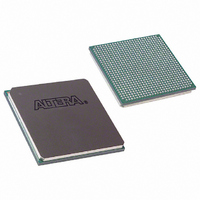EP1S10F780I6N Altera, EP1S10F780I6N Datasheet - Page 595

EP1S10F780I6N
Manufacturer Part Number
EP1S10F780I6N
Description
IC STRATIX FPGA 10K LE 780-FBGA
Manufacturer
Altera
Series
Stratix®r
Datasheet
1.EP1S10F484I6N.pdf
(864 pages)
Specifications of EP1S10F780I6N
Number Of Logic Elements/cells
10570
Number Of Labs/clbs
1057
Total Ram Bits
920448
Number Of I /o
426
Voltage - Supply
1.425 V ~ 1.575 V
Mounting Type
Surface Mount
Operating Temperature
0°C ~ 85°C
Package / Case
780-FBGA
Lead Free Status / RoHS Status
Lead free / RoHS Compliant
Number Of Gates
-
Available stocks
Company
Part Number
Manufacturer
Quantity
Price
Company:
Part Number:
EP1S10F780I6N
Manufacturer:
ALTERA
Quantity:
3 000
- Current page: 595 of 864
- Download datasheet (11Mb)
Altera Corporation
September 2004
Implementing High Performance DSP Functions in Stratix & Stratix GX Devices
user needs a way to accept this sample data and send it at a 4r rate to the
input of the DSP block. One way to do this is using a first-in-first-out
(FIFO) memory with input clocked at rate r and output clocked at rate 4r.
The FIFO may be implemented in the TriMatrix memory.
TDM Filter Implementation Results
Table 7–8
FIR filter as shown in
TDM Filter Design Example
Download the TDM FIR Filter (tdm_fir.zip) design example from the
Design Examples section of the Altera web site at www.altera.com.
Polyphase FIR Interpolation Filters
An interpolation filter can be used to increase sample rate. An
interpolation filter is efficiently implemented with a polyphase FIR filter.
DSP systems frequently use polyphase filters because they simplify
overall system design and also reduce the number of computations per
cycle required of the hardware. This section first describes interpolation
filters and then how to implement them as polyphase filters in Stratix and
Stratix GX devices. See the
page 7–24
Interpolation Filter Basics
An interpolation filter increases the output sample rate by a factor of I
through the insertion if I-1 zeros between input samples, a process
known as zero padding. After the zero padding, the output samples in
time domain are separated by Ts/I = 1/(I f
sample period and sample frequency of the original signal, respectively.
Figure 7–10
Note to
(1)
Part
Utilization
Performance
Table 7–8. TDM Filter Implementation Results
This refers to the performance of the DSP blocks. The input and output rate is 120
million samples per second (MSPS), clocked in and out at 120 MHz.
Table
shows the results of the implementation of an 18-bit 8-tap TDM
section for a discussion of decimation filters.
shows the concept of signal interpolation.
7–8:
EP1S10F780
Lcell: 196/10570 (1%)
DSP Block 9-bit elements: 8/48 (17%)
Memory bits: 360/920448 (<1%)
240 MHz
Figure 7–9 on page
“Polyphase FIR Decimation Filters” on
(1)
Stratix Device Handbook, Volume 2
7–16.
s
), where T
s
and f
s
are the
7–17
Related parts for EP1S10F780I6N
Image
Part Number
Description
Manufacturer
Datasheet
Request
R

Part Number:
Description:
CYCLONE II STARTER KIT EP2C20N
Manufacturer:
Altera
Datasheet:

Part Number:
Description:
CPLD, EP610 Family, ECMOS Process, 300 Gates, 16 Macro Cells, 16 Reg., 16 User I/Os, 5V Supply, 35 Speed Grade, 24DIP
Manufacturer:
Altera Corporation
Datasheet:

Part Number:
Description:
CPLD, EP610 Family, ECMOS Process, 300 Gates, 16 Macro Cells, 16 Reg., 16 User I/Os, 5V Supply, 15 Speed Grade, 24DIP
Manufacturer:
Altera Corporation
Datasheet:

Part Number:
Description:
Manufacturer:
Altera Corporation
Datasheet:

Part Number:
Description:
CPLD, EP610 Family, ECMOS Process, 300 Gates, 16 Macro Cells, 16 Reg., 16 User I/Os, 5V Supply, 30 Speed Grade, 24DIP
Manufacturer:
Altera Corporation
Datasheet:

Part Number:
Description:
High-performance, low-power erasable programmable logic devices with 8 macrocells, 10ns
Manufacturer:
Altera Corporation
Datasheet:

Part Number:
Description:
High-performance, low-power erasable programmable logic devices with 8 macrocells, 7ns
Manufacturer:
Altera Corporation
Datasheet:

Part Number:
Description:
Classic EPLD
Manufacturer:
Altera Corporation
Datasheet:

Part Number:
Description:
High-performance, low-power erasable programmable logic devices with 8 macrocells, 10ns
Manufacturer:
Altera Corporation
Datasheet:

Part Number:
Description:
Manufacturer:
Altera Corporation
Datasheet:

Part Number:
Description:
Manufacturer:
Altera Corporation
Datasheet:

Part Number:
Description:
Manufacturer:
Altera Corporation
Datasheet:

Part Number:
Description:
CPLD, EP610 Family, ECMOS Process, 300 Gates, 16 Macro Cells, 16 Reg., 16 User I/Os, 5V Supply, 25 Speed Grade, 24DIP
Manufacturer:
Altera Corporation
Datasheet:












